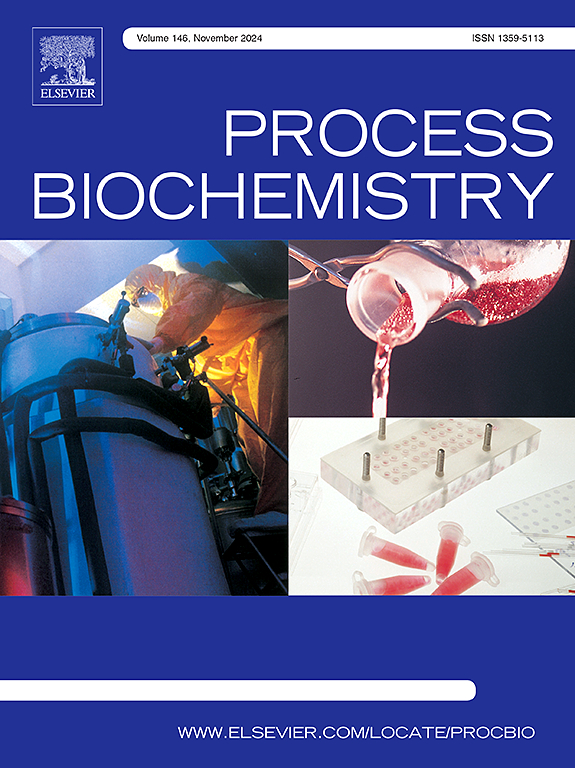植物甾醇在新金黄色分枝杆菌中转化为9-羟基-3-氧-4-孕烯-20-羧酸甲酯
IF 4
3区 生物学
Q2 BIOCHEMISTRY & MOLECULAR BIOLOGY
引用次数: 0
摘要
9-羟基-3-氧-4-孕烯-20-羧酸甲酯(9-OH-3-OPCM)是孕基药物合成中具有代表性的C-22甾体前体。然而,由于类固醇代谢途径的复杂性,新aurum分枝杆菌(M. neoaurum)从植物甾醇生产9-OH-3-OPCM仍然不发达。在这项研究中,我们对新aurum的植物甾醇代谢进行了基因改造,获得了85.9 %的9-OH-3-OPCM的摩尔产率,并且副产物最少。首先,通过破坏缺乏kstds的新金鼠的ChsE1-2和ChsH1-2,实现了9-OH-3-OPCM的生物合成。然后,失活ChsE4-5、Opccr和SalA编码的关键酶,减少副产物9-羟基-3-氧-4,17-预二烯-20-羧酸甲酯(9- oh -3- opdcm)和9,21-二羟基-20-甲基-孕-4-en-3-one (9- oh -4- hbc)的形成,增加9- oh -3- opcm的产量。值得注意的是,多个甲基转移酶被过度表达和筛选,以克服从前体9-羟基-3-氧-4-孕烯-20-羧酸甲酯(9-OH-3-OPC)到9-OH-3-OPCM的次优生物转化,这是由于甲基转移酶活性不足造成的。总的来说,我们的研究结果表明了一种提高新aurum中9-OH-3-OPCM生物合成效率和纯度的策略。本文章由计算机程序翻译,如有差异,请以英文原文为准。
Bioconversion of phytosterols to 9-hydroxy-3-oxo-4-pregnene-20-carboxylic acid methyl ester by rerouting of phytosterol degradation pathways in Mycolicibacterium neoaurum
9-Hydroxy-3-oxo-4-pregnene-20-carboxylic acid methyl ester (9-OH-3-OPCM) is a representative C-22 steroid precursor in the synthesis of progestational based drug. However, 9-OH-3-OPCM production from phytosterol in Mycolicibacterium neoaurum (M. neoaurum) remains underdeveloped due to the complexity of the steroid metabolic pathway. In this study, we genetically modified the phytosterol metabolism in M. neoaurum and achieved an 85.9 % molar yield of 9-OH-3-OPCM with minimal by-products. Firstly, the biosynthesis of 9-OH-3-OPCM was achieved by disrupting ChsE1–2 and ChsH1–2 in KstDs-deficient M. neoaurum. Then, key enzymes encoded by ChsE4–5, Opccr, and SalA were inactivated to reduce the formation of by-products 9-hydroxy-3-oxo-4,17-pregadiene-20-carboxylic acid methyl ester (9-OH-3-OPDCM) and 9,21-dihydroxy-20-methyl-pregna-4-en-3-one (9-OH-4-HBC), as well as to increase 9-OH-3-OPCM production. Notably, multiple methyltransferases were overexpressed and screened to overcome suboptimal bioconversion from precursor 9-hydroxy-3-oxo-4-pregnene-20-carboxylic acid methyl ester (9-OH-3-OPC) to 9-OH-3-OPCM, which was attributed to inadequate methyltransferase activity. Overall, our findings demonstrate a strategy to improve the efficiency and purity of 9-OH-3-OPCM biosynthesis in M. neoaurum.
求助全文
通过发布文献求助,成功后即可免费获取论文全文。
去求助
来源期刊

Process Biochemistry
生物-工程:化工
CiteScore
8.30
自引率
4.50%
发文量
374
审稿时长
53 days
期刊介绍:
Process Biochemistry is an application-orientated research journal devoted to reporting advances with originality and novelty, in the science and technology of the processes involving bioactive molecules and living organisms. These processes concern the production of useful metabolites or materials, or the removal of toxic compounds using tools and methods of current biology and engineering. Its main areas of interest include novel bioprocesses and enabling technologies (such as nanobiotechnology, tissue engineering, directed evolution, metabolic engineering, systems biology, and synthetic biology) applicable in food (nutraceutical), healthcare (medical, pharmaceutical, cosmetic), energy (biofuels), environmental, and biorefinery industries and their underlying biological and engineering principles.
 求助内容:
求助内容: 应助结果提醒方式:
应助结果提醒方式:


